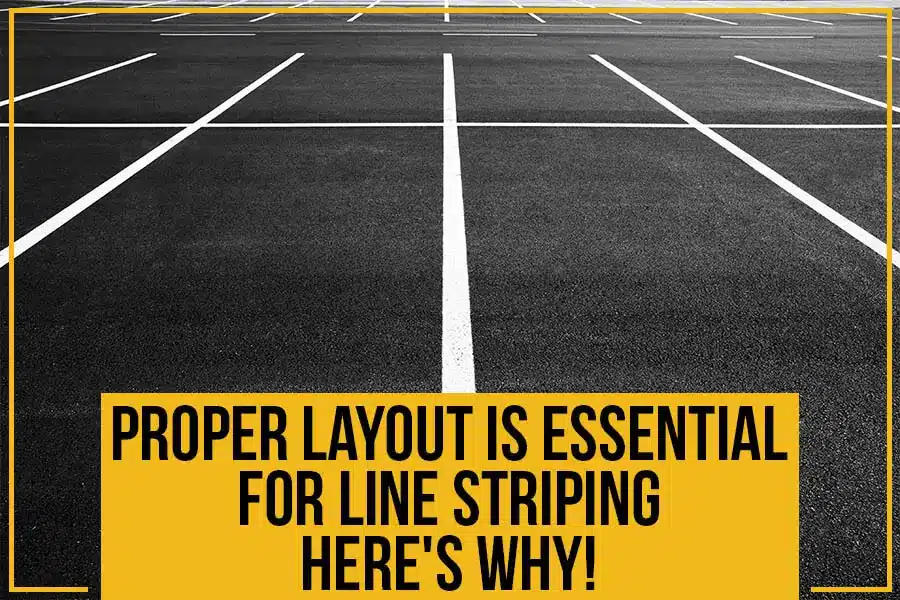Key Takeaways:
- Parking lot striping is the application of paint markings on the pavement to highlight traffic control routes, allow signage, and outline accessible stalls for ADA compliance.
- A parking lot layout is a basis for installing various stripes, pavement stencils, signage, and spacings to enhance the safety and capacity of the plot.
- Orientation, aisle placements, stall widths, disability ramp clearances, and accessible stalls are crucial elements in a parking lot layout.
- End islands are crucial parking lot details included in a layout at the ends of the aisle when cars turn. The feature offers reversing and turning drivers some clearance and protection from colliding into other vehicles.
- Parking lot maintenance is critical to the overall look and degree of compliance afforded to visitors and residents. Faded lines tend to confuse drivers and cause accidents.
- For durable striping and space optimization in a parking lot, you can trust Proline Parking Lot Maintenance to get the job done right!
Pavement striping is not just painted stripes and arrows on asphalt. There is a certain design to maximize the space’s utility and offer safe and accessible parking for residents and visitors alike. That is known as a parking lot layout, and striping is practically futile unless you have a good one.
When your parking lot layout isn’t up to code, it can be a lawsuit waiting to happen. Curbs, fire lanes, handicap spots, and other features must be well-marked so drivers know where they can and cannot park. This not only keeps everyone safe but also helps with an efficient redirection of traffic through the intended lanes.
Today, Proline Parking Lot Maintenance will focus on having a layout before pavement striping occurs. But first, we focus on how ADA guidelines impact the layout and signage design.
Related: Can You Measure The Success Of Your Parking Lot?
ADA Compliance: Why Does It Feature in Parking Lot Striping?
Parking lots are meant to facilitate people from all walks of life. Factors like poor lot design faded signage and pavement striping, and unkempt pavement can lead to damage to property and life.
The ADA exists to rectify, retrofit, and ensure that municipal, commercial and residential spaces are designed to accommodate the access of the disabled and elderly. That makes it easier for them to adapt, be mobile and integrate with society.
ADA guidelines have strict design considerations to ensure that parking spaces are aptly spaced in a parking lot and there are no streetscape features that might be detrimental to the movement of disabled individuals and citizens in general.
If regarded in terms of ADA compliance, line striping sets spacing for vehicles, door clearances, and designated accessible parking slots. In terms of paving, it also acts as a traffic control and rerouting element. Maintained striping can also boost the curb appeal and generate ROI.
Parking Lot Layout Requirements
Just like a painter needs inspiration and direction before the first brushstroke on a canvas, a paving contractor needs an efficient parking layout before laying out the first stripe. It is a way to guide visitors and residents to park their cars safely, with enough clearance to avoid accidents, and maintain sufficient spaces for ramps, rails, and stairs.
To make the layout easier to design, you can contact the local municipality for compliance and codes and then begin with the project.
Layout Elements
The Angle of The Parking Stall
The best lot configuration is rectangular, with a central aisle and stalls on either side. Stalls must be perpendicular to the traffic aisles to sustain a two-way traffic flow. The more acute this angle goes, the less efficient the layout is. For high-traffic lots, stall angles at 45-60 are still optimal for quick pull-in and pull-out.
Row Orientation
Typically, a parking lot’s orientation is 90 degrees to the nearest building to afford protection for pedestrians. If the lot is less than 130 ft long, the layout should be installed parallel to the buildings.
The Entrance and Exit Points
In an optimal parking lot layout, the entrance and exit paths must continue the traffic from the main aisles. Avoid having parking lot features like sharp turns and ungainly speed bumps. And there should be ample space for stalls closer to the entrance so they don’t back up into a pole or a curb.
Aisle Orientation
In a rectangular parking lot, the most efficient orientation is for the traffic aisles to be parallel along the width of the parking lot. This is purported to enhance lot capacity by almost 20%. For longer lots, cross aisles are ideally introduced for every 30 spaces.
End Islands
The spaces at the ends of all aisles must clear any parking stalls to provide turning space for vehicles and a clear view of the cross-aisle. This is usually highlighted with pavement striping or installing a curbed ‘island.’ These raised islands also provide spots to install signage and light fixtures.
They also serve an aesthetic function by providing swathes of green in the sea of asphalt.
Lot Striping Surface Prep
To prepare your parking lot for a fresh batch of pavement striping, you need to strip the pavement of existing stripes and then begin afresh. And if you are going DIY, do not paint over faded lines, as it will result in a faster deterioration of the new stripes. Clean surfaces are crucial to ensure the paint sticks, so various activities are carried out to prep the surface.
The existing pavement stripes are removed using various techniques and equipment, such as a sandblaster, grinders, burning, or even chemical peels. While all the stripe removal methods are optimal, the issue with grinding and chemical peels is that one removes ravels at the top of the pavement. The other can potentially weaken the chemical bonds in the asphalt binder.

Parking Lot Repairs
After that, any potholes, cracks, and surface irregularities need addressing. You may have to schedule resurfacing or full-depth repairs if the damage is too severe.
The weather in Huntersville, NC, is still ideal for asphalt paving (50-70 F) and striping, which can be done at temperatures as low as 40F. For that, you need further pavement cleaning, so it will allow the asphalt patches and crack fillers to set inappropriately.
Then you can begin with a thorough wash of the repaired pavement. Remove any traces of oil and greasy contaminants, as they can affect paint adhesiveness. Allow the parking lot to dry out completely before starting the pavement striping project.
Related: 5 Things To Consider When Budgeting For A Pothole Repair Project
There are still many small business owners and lot managers who attempt to DIY their way with parking lot striping and often mess up. Either the paint won’t stick, or their new layout is causing too many fender benders. For this reason, it is ideal to entrust the layout design to professionals like those at Proline Parking Lot Maintenance.
We are the Greater Charlotte Area’s #1 Pavement Maintenance Company. We offer unparalleled paving, layout design and striping services in Charlotte, NC, and the surrounding areas. Just remember, striping is pointless without a fantastic layout and maintained pavement. So, get in touch with our representative and schedule your lots for inspection.
We also offer free estimates on our services; get yours today!










